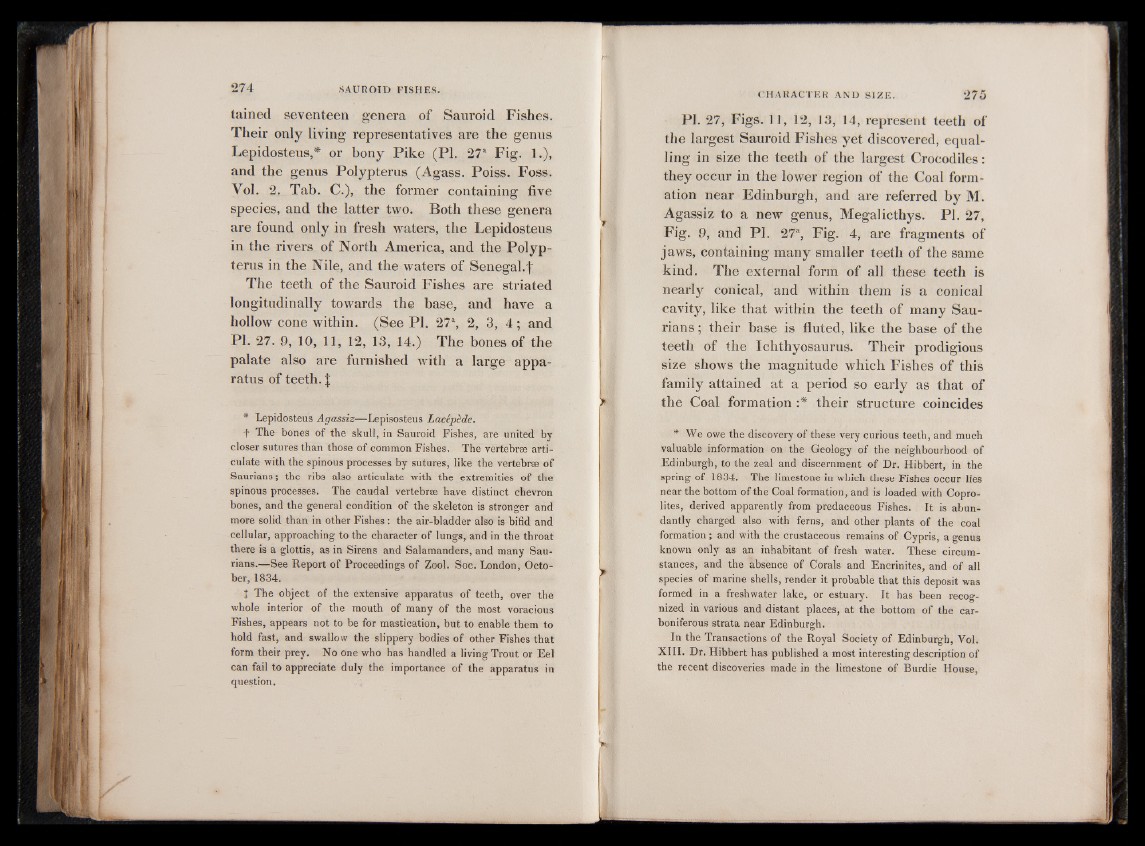
tained seventeen genera of Sauroid Fishes.
Their only living representatives are the genus
Lepidosteus,* or bony Pike (PL 27a Fig. 1.),
and the genus Polypterus (Agass. Poiss. Foss.
Vol. 2. Tab. C.), the former containing five
species, and the latter two. Both these genera
are found only in fresh waters, the Lepidosteus
in the rivers of North America, and the Polypterus
in the Nile, and the waters of Senegal.^
The teeth of the Sauroid Fishes are striated
longitudinally towards the base, and have a
hollow cone within. (See PI. 27% 2, 3, 4; and
Pl. 27. 9, 10, 11, 12, 13, 14.) The bones of the
palate also are furnished with a large apparatus
of teeth. |
* Lepidosteus Agassiz—Lepisosteus Lacépède.
f The bones of the skull, in Sauroid Fishes, are united by
closer sutures than those of common Fishes. The vertebrae articulate
with the spinous processes by sutures, like the vertebrae of
Saurians; the ribs also articulate with the extremities of the
spinous processes. The caudal vertebrae have distinct chevron
bones, and the general condition of the skeleton is stronger and
more solid than in other Fishes: the air-bladder also is bifid and
cellular, approaching to the character of lungs, and in the throat
there is a glottis, as in Sirens and Salamanders, and many Saurians.—
See Report of Proceedings of Zool. Soc. London, October,
1834.
1 The object of the extensive apparatus of teeth, over the
whole interior of the mouth of many of the most voracious
Fishes, appears not to be for mastication, but to enable them to
hold fast, and swallow the slippery bodies of other Fishes that
form their prey. No one who has handled a living Trout or Eel
can fail to appreciate duly the importance of the apparatus in
question.
PL 27, Figs. 11, 12, 13, 14, represent teeth of
the largest Sauroid Fishes yet discovered, equalling
in size the teeth of the largest Crocodiles :
they occur in the lower region of the Coal formation
near Edinburgh, and are referred by M.
Agassiz to a new genus, Megalicthys. PL 27,
Fig. 9, and PL 27% Fig. 4, are fragments of
jaws, containing many smaller teeth of the same
kind. The external form of all these teeth is
nearly conical, and within them is a conical
cavity, like that within the teeth of many Saurians
; their base is fluted, like the base of the
teeth of the Ichthyosaurus. Their prodigious
size shows the magnitude which Fishes of this
family attained at a period so early as that of
the Coal formation :* their structure coincides
* We owe the discovery of these very curious teeth, and much
valuable information on the Geology of the neighbourhood of
Edinburgh, to the zeal and discernment of Dr. Hibbert, in the
spring of 1834. The limestone in which these Fishes occur lies
near the bottom of the Coal formation, and is loaded with Copro-
lites, derived apparently from predaceous Fishes. It is abundantly
charged also with ferns, and other plants of the coal
formation ; and with the crustaceous remains of Cypris, a genus
known only as an inhabitant of fresh water. These circumstances,
and the absence of Corals and Encrinites, and of all
species of marine shells, render it probable that this deposit was
formed in a freshwater lake, or estuary. It has been recognized
in various and distant places, at the bottom of the carboniferous
strata near Edinburgh.
In the Transactions of the Royal Society of Edinburgh, Vol.
XIII. Dr. Hibbert has published a most interesting description of
the recent discoveries made in the limestone of Burdie House,